Yves GARY Hits: 7521
Category: DESIGNERS
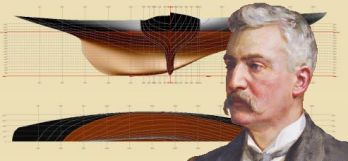 George Lennox Watson was born in Glasgow in the same year in which the schooner America was built and raced; his father, Dr. Watson, was a noted physician, his mother was a Miss Burstall, daughter of Timothy Burstall, an inventor, and a contemporary of George Stevenson, builder of the locomotive Rocket, and engaged in similar work.
George Lennox Watson was born in Glasgow in the same year in which the schooner America was built and raced; his father, Dr. Watson, was a noted physician, his mother was a Miss Burstall, daughter of Timothy Burstall, an inventor, and a contemporary of George Stevenson, builder of the locomotive Rocket, and engaged in similar work.
At the age of sixteen, Mr. Watson, whose tastes as a young boy inclined ..
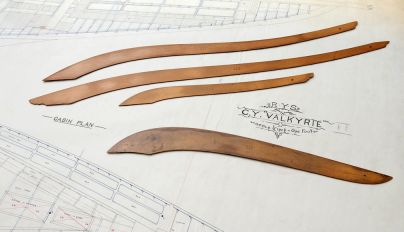 ... toward the water and boats, entered the famous shipyard of R. Napier & Son, of Govan and Lancefield, on the Clyde, as a draftsman. From Napier’s yard the young draftsman went to that of A. & J. Inglis, at Pointhouse. While here, at the age of twenty, he made his first attempt at yacht designing and building, strange to say, in a wide and shoal boat of the American type, though with a fixed keel, by name Peg Woffington. She was a queer little craft, with a ram bow and a strong tumble-home to the topsides, and very hollow water lines aft as well as forward; sad to say, she did not prove a success.
... toward the water and boats, entered the famous shipyard of R. Napier & Son, of Govan and Lancefield, on the Clyde, as a draftsman. From Napier’s yard the young draftsman went to that of A. & J. Inglis, at Pointhouse. While here, at the age of twenty, he made his first attempt at yacht designing and building, strange to say, in a wide and shoal boat of the American type, though with a fixed keel, by name Peg Woffington. She was a queer little craft, with a ram bow and a strong tumble-home to the topsides, and very hollow water lines aft as well as forward; sad to say, she did not prove a success.
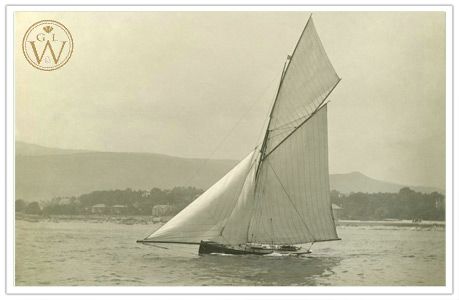 In 1873 at the age of just 22 Watson set up the world’s first dedicated yacht design office. In 1875 he designed the 5-ton racing cutter Clotilde, beating the Fairlie 5-tonner Pearl, then the crack of the class on the Clyde. In the following year he designed another 5-tonner, Vril, building her himself with two other enthusiastic amateurs, John Laurence and J. B. Hilliard, part owners. She was built in a corner of the Henderson yard at Meadowside, with the assistance of a couple of ship carpenters.
In 1873 at the age of just 22 Watson set up the world’s first dedicated yacht design office. In 1875 he designed the 5-ton racing cutter Clotilde, beating the Fairlie 5-tonner Pearl, then the crack of the class on the Clyde. In the following year he designed another 5-tonner, Vril, building her himself with two other enthusiastic amateurs, John Laurence and J. B. Hilliard, part owners. She was built in a corner of the Henderson yard at Meadowside, with the assistance of a couple of ship carpenters.
Sailed through the season by her young owners she proved the head of the class, no small honor as it then stood. In 1877 he turned out for his friend Robert Wylie of Glasgow, the 10-tonner Verve I, an odd-looking craft, with bluff bows and a short counter, and in the following year another ten, the Quiraing.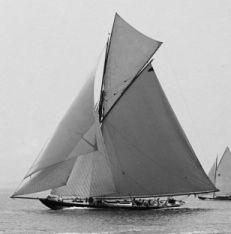 This yacht was raced in the 10-ton class and made more than a local reputation for her young designer, paving the way for the famous Madge, built in 1879. In her first year Madge started in 24 races, winning 22 first and 2 second prizes of a total value of £395, her second season’s win being £291.
This yacht was raced in the 10-ton class and made more than a local reputation for her young designer, paving the way for the famous Madge, built in 1879. In her first year Madge started in 24 races, winning 22 first and 2 second prizes of a total value of £395, her second season’s win being £291.
Mr. Watson was now fairly launched as a yacht designer; he had been personally concerned in the building of the Vril and several other yachts, but had never made a business of yacht building, from the first devoting himself solely to designing. His first large commission came in 1880, when he designed the racing 90-tonner Vanduara, of steel, for Mr. Stewart Clark, who won with her £1,030.
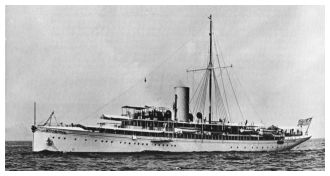 In 1882 he designed the iron steam yacht Sweetheart, of 121 tons, but his first important venture in steam was in 1885, when he designed the Amy, of 812 tons, following her with the Mohican, of 704 tons, in the same year. Since then he has devoted his time to sail and steam alike, designing in all over 200 yachts up to the new Lysistrata, for Mr. James Gordon Bennett, launched last year, a steam yacht of 2,082 tons. It can safely be said that the Watson steam yachts represent the highest standard of style throughout the world. Like Mr. Fife, Mr. Watson has been in a measure conservative even in the designing of racing yachts, always turning out as good a craft, both in design and construction, as the existing rules and conditions would admit.
In 1882 he designed the iron steam yacht Sweetheart, of 121 tons, but his first important venture in steam was in 1885, when he designed the Amy, of 812 tons, following her with the Mohican, of 704 tons, in the same year. Since then he has devoted his time to sail and steam alike, designing in all over 200 yachts up to the new Lysistrata, for Mr. James Gordon Bennett, launched last year, a steam yacht of 2,082 tons. It can safely be said that the Watson steam yachts represent the highest standard of style throughout the world. Like Mr. Fife, Mr. Watson has been in a measure conservative even in the designing of racing yachts, always turning out as good a craft, both in design and construction, as the existing rules and conditions would admit.
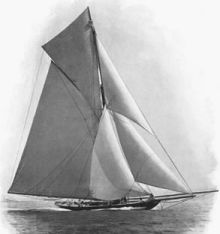 Watson stood at the pinnacle of his profession; yet never stopped designing fast boats. While he had refused Sir Thomas Lipton’s commissions twice because of the stress of Cup campaigns, Watson couldn’t help but design yet another boat to beat all comers. In 1900, he launched Kariad, a light displacement hull that so dominated the racing circuit in home waters, that she was destroyed after Watson’s death to open the door to a new generation of yachts and designers.
Watson stood at the pinnacle of his profession; yet never stopped designing fast boats. While he had refused Sir Thomas Lipton’s commissions twice because of the stress of Cup campaigns, Watson couldn’t help but design yet another boat to beat all comers. In 1900, he launched Kariad, a light displacement hull that so dominated the racing circuit in home waters, that she was destroyed after Watson’s death to open the door to a new generation of yachts and designers.
1902 In the early years of his adult life Watson was devoted his company as well as close friends and family. He had little time for courting and it was not until his later years that Watson courted and married Ms Lovibond of Putney, London. Their wedding was described as "a gathering of the most fashionable people in society".
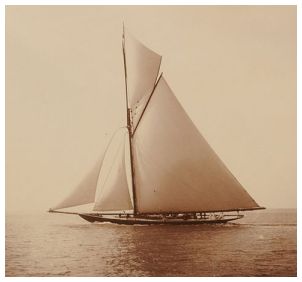 1904 November 12th. Only 18 months after their wedding, and shortly after the birth of his daughter, Ellen Marjorie (Madge). Watson succumbed to "Coronary Asthma" and died aged 53.
1904 November 12th. Only 18 months after their wedding, and shortly after the birth of his daughter, Ellen Marjorie (Madge). Watson succumbed to "Coronary Asthma" and died aged 53.
Watson designed 432 yachts, lifeboats and other vessels during his 32-year career, an output which averages one new build launched every 3.5 weeks. Probably the best known of his creations is the Britannia, owned by King Edward. This famous yacht was built while the King was Prince of Wales and remained unbeaten in her class. Among the boats defeated by the Britannia was the Vigilant, which went abroad after successfully defending the America‘s Cup.
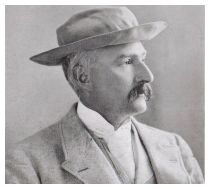 Shamrock II, which came nearest of all the Shamrock to winning the America's Cup was designed by Watson, and Americans will remember that the margin between the British boat and Columbia was very close. Watson also designed the two Valkyries and the Thistle. Capt. “Nat” Herreshoff once admitted that Watson was the one British designer of whom he was afraid.
Shamrock II, which came nearest of all the Shamrock to winning the America's Cup was designed by Watson, and Americans will remember that the margin between the British boat and Columbia was very close. Watson also designed the two Valkyries and the Thistle. Capt. “Nat” Herreshoff once admitted that Watson was the one British designer of whom he was afraid.
When Watson designed the Thistle, the trim boat that caused such a panic among American yachtsmen, he was sure that he was going to win the cup. After the races were over and the cup remained safe on this side Watson said: “ I lost that cup because of my wonderful Scotch parsimony. I was afraid to spend proper money on proper sails. It saved the cup for America. It lost it for me.”

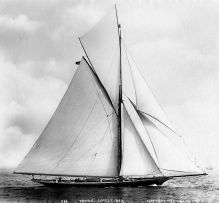 |
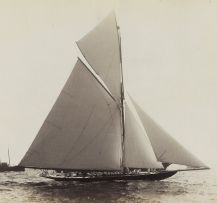 |
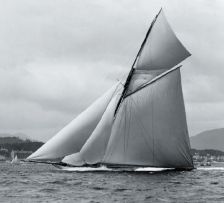 |
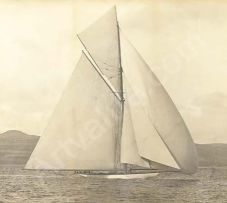 |
| THISTLE (1887) | VALKYRIE II (1893) | VALKYRIE III (1895) | SHAMROCK II (1901) |

George Lennox Watson — Wikipédia
- George Lennox Watson, 1851-1904 - Wooden Boatworks
- George Lennox Watson, 1995 Inductee - Herreshoff Marine Museum & America's Cup Hall of Fame
- George Lennox Watson 1851-1904 - Scotland and the Antarctic
- George Lennox Watson - Grace's Guide
- George Lennox Watson (1851–1904) - Classic Sailboats
- G.L. Watson — Friends of Glasgow Necropolis
- G.L. Watson - Peggy Bawn Press
- Archive - G.L. Watson & Co.

Wooden Boatworks